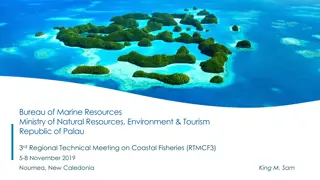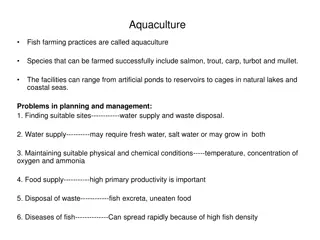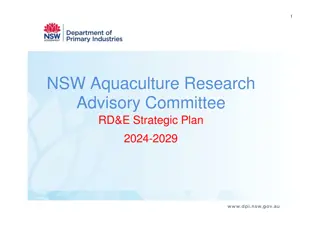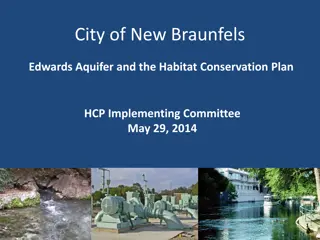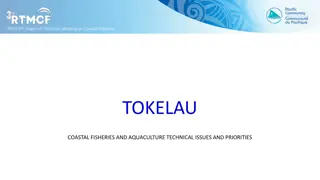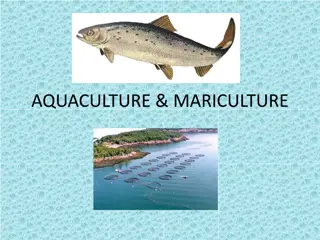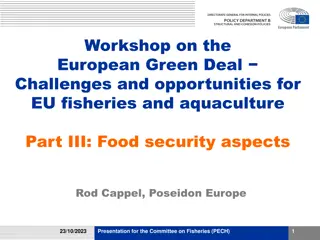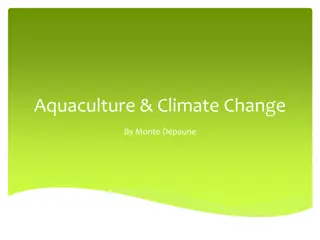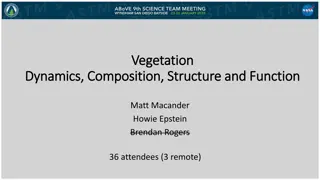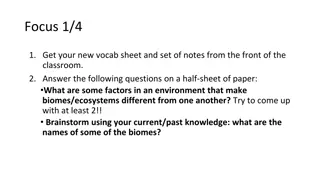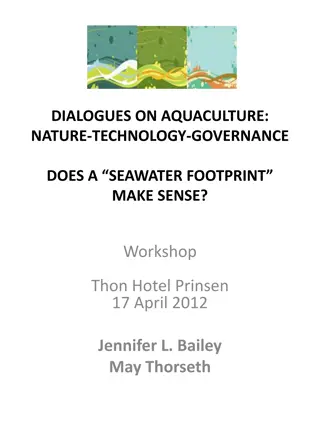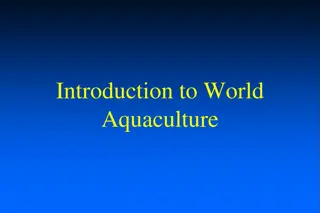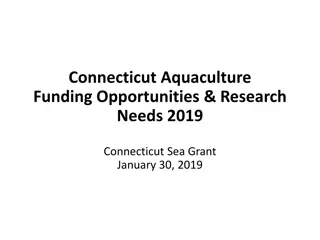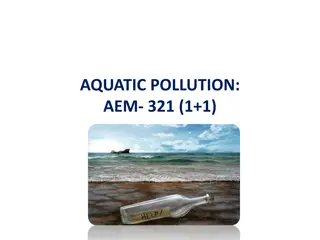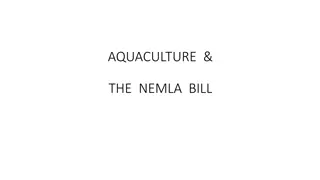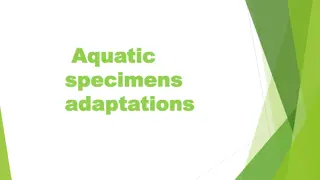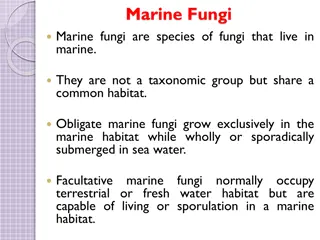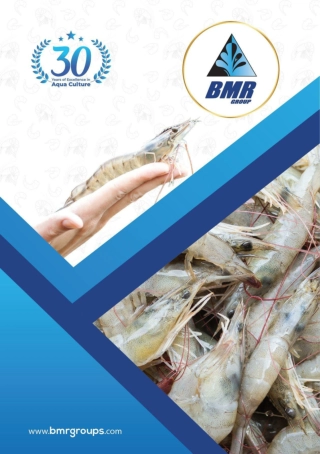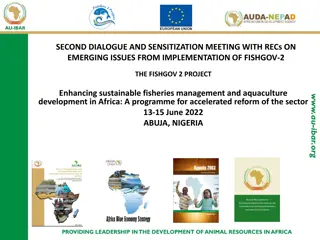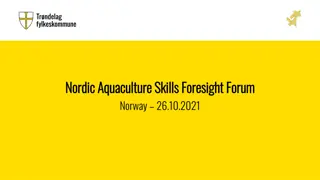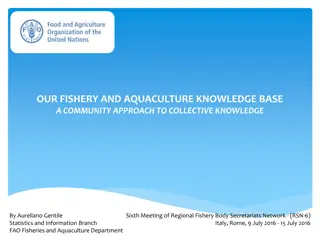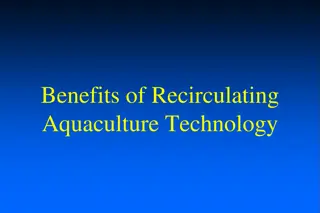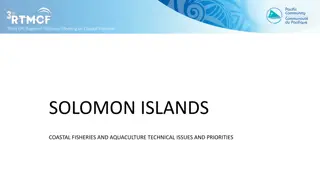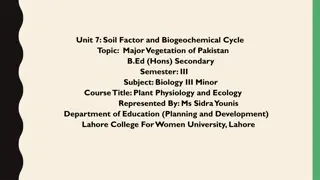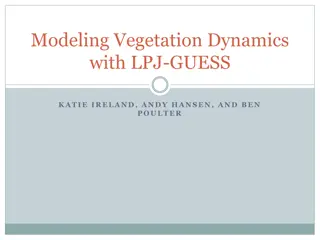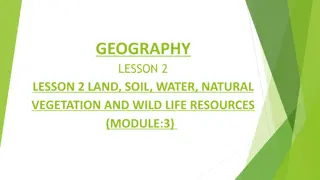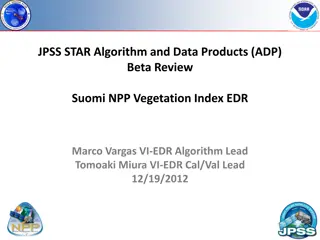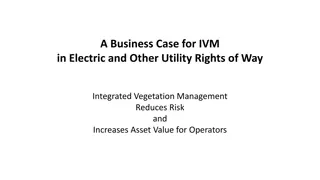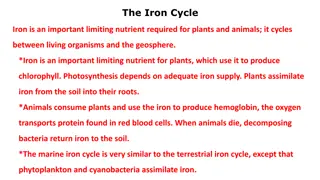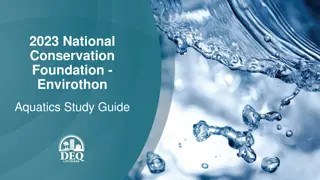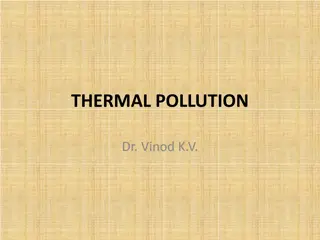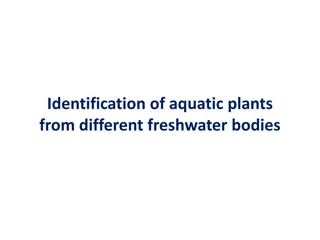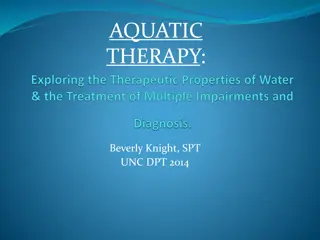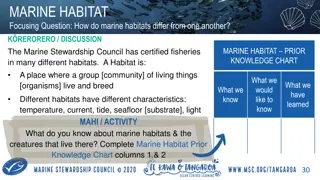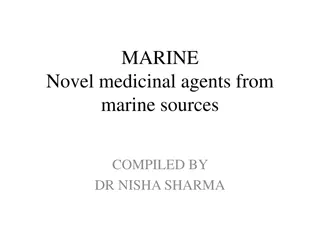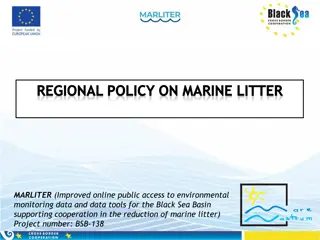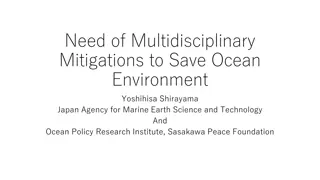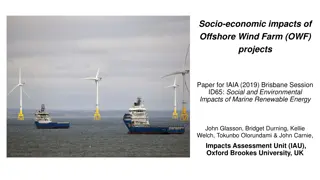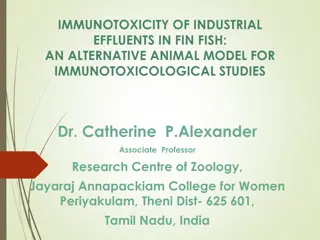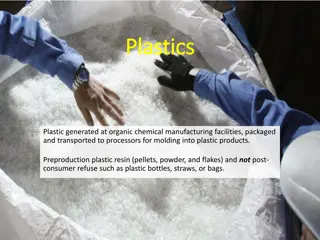Marine Aquaculture Impacts on Submersed Aquatic Vegetation
The document explores the impacts of structures and shading used in commercial shellfish mariculture activities on submersed aquatic vegetation, particularly seagrasses. It discusses the varying effects of mariculture structures on eelgrass density, productivity, and the potential habitat they provide for various aquatic organisms. Additionally, it examines the positive and negative impacts of bivalves and bivalve aquaculture on seagrass ecosystems. The text emphasizes the importance of understanding different mariculture techniques and their distinct impacts on marine environments.
- Marine Aquaculture
- Submersed Aquatic Vegetation
- Seagrasses
- Commercial Shellfish Mariculture
- Bivalve Aquaculture
Uploaded on Oct 04, 2024 | 0 Views
Download Presentation

Please find below an Image/Link to download the presentation.
The content on the website is provided AS IS for your information and personal use only. It may not be sold, licensed, or shared on other websites without obtaining consent from the author. Download presentation by click this link. If you encounter any issues during the download, it is possible that the publisher has removed the file from their server.
E N D
Presentation Transcript
Timescale of Effects STRUCTURES/SHADING Acute Cumulative Neutral/Positive Neutral/positive impacts with temporary effects. Neutral/positive impacts with long-term effects. 1 2 5 Nature of Impacts Minimal impacts with temporary effects. Minimal impacts with long-term effects. Minimal 1 5 3 Severe impacts with temporary effects. Severe impacts with long-term effects. Severe 4 5
STRUCTURES/SHADING 1. (Skinner, et al. 2014) Long lines, suspended bags, and floating bags used for commercial shellfish mariculture activities can shade submersed aquatic vegetation, but the severity of those shading effects on seagrasses is depending [sic] on the configuration of those structures. [ACOE 2020] The reference is shown in two cells because impacts are location-dependent. 2. (Tallis et al. 2009) Throughout the bay, eelgrass in long line areas occurred at densities indistinguishable from nearby uncultivated areas, but in 2004, eelgrass in long line areas was smaller (32%) and had lower production per area (70%). [ACOE 2020] 3. (D Amourset al. 2008, Powers et al. 2007) Mariculture structures can provide habitat for organisms in a manner similar to artificial reefs by attracting epibiotic organisms as well as mobile invertebrates, such as crabs, and fish to areas that previously had no structural habitat (e.g., sand flats without submersed aquatic vegetation). Mariculture structures can also provide refuge from predators, by giving aquatic organisms places to hide. This was placed here because there can also be invasive species (e.g. bryozoans) that can have minimal negative/neutral impacts. 4. (Griffin, 1997) [O]ff-bottom culture, particularly rack culture, results in shading and erosion of sedimentation that appear to be the primary cause of eelgrass depletion in those areas. Both rack and stake culture cause a decrease in eelgrass, and stake culture additionally results in an increase in algae such as Ulva (sea lettuce) and Enteromorpha. Excessive growth of these algae on eelgrass are suspected of having a negative effect on eelgrass. [NMFS 2016]. Group discussed long-term impacts, but levels of severity depend on siting and management. 5. (Tallis et al. 2009) The presence of bivalves and bivalve aquaculture can have positive and negative impacts on seagrass and associated benthic communities. Group noted that it's important to separate out culture types (e.g. long lines and flip bags) because they will have different impacts due to their nature of the growing techniques
GRAVEL/SHELL Timescale of Effects Acute Cumulative Neutral/Positive Neutral/positive impacts with temporary effects. Neutral/positive impacts with long-term effects. 2 7 8 10 5 3 Nature of Impacts Minimal impacts with temporary effects. Minimal impacts with long-term effects. Minimal 4 9 1 6 6 Severe impacts with temporary effects. Severe impacts with long-term effects. Severe
GRAVEL/SHELL (1) 1. Discharges of dredged or fill material into waters of the United States for commercial shellfish mariculture activities may cover submersed aquatic vegetation, when on-bottom culture methods involve discharges of shell, gravel, and other materials to create flats or mounds to which bivalve shellfish larvae can attach to and grow. 2. Discharges of shell, gravel and other materials used for on-bottom commercial shellfish mariculture activities may provide structural habitat that attracts fish, crustaceans, and other aquatic organisms by providing substrate upon which epibiotic (fouling) organisms can become established and grow (e.g., Dumbauld et al. 2015, D Amour et al. 2008, Powers et al. 2007, Hosack et al. 2006, NRC 2010), and those epibiotic organisms may serve as a food source for aquatic organisms. 3. Discharges of dredged material into waters of the United States for commercial shellfish mariculture activities may occur during bivalve shellfish harvesting activities, as well as harrowing, raking, and levelling activities to smooth out the substrate for bivalve shellfish production. These activities may adversely affect water quality by releasing sediments into the water column. 4. These activities [discharges of dredged material] may adversely affect benthic organisms such as seagrasses, algae, epibenthic invertebrates, benthic invertebrates that live in the substrate, and fish. 5. These activities [discharges of dredged material] may also cause disturbances that cause fish, invertebrates, and other organisms to avoid the site of the NWP activity. 6. (Simenstad and Fresh 1995) Some commercial shellfish mariculture activities involve bed preparation by depositing gravel or shell on the bottom of the waterbody to provide substrate for larval shellfish to attach and grow (NRC 2010). The increase in habitat complexity due to the deposition of shell on the bottom of the waterbody can support a variety of plants and animals, including benthic and epibenthic organisms. The group placed this on the matrix with respect to salmon.
GRAVEL/SHELL (2) 7. Shell, gravel, or other appropriate material deposited on the bottom of the waterbody for commercial shellfish mariculture activities can provide suitable substrate for larval bivalve mollusks to attach to and grow. The bivalve mollusks that are produced through these activities are likely to contribute to the ecological functions and services performed by the waterbody. The shell, gravel, or other appropriate material, plus the bivalve shellfish grow on that substrate, may be colonized by epibiotic organisms such as macroalgae, barnacles, other bivalve mollusk species, bryozoans, sponges, and tunicates (NRC 2010) that may provide additional ecological functions and services, including food that supports the production of fish, large crustaceans, and aquatic organisms. 8. (Simenstad and Fresh 1995) The structured habitat provided by commercial shellfish mariculture activities can be higher in habitat value than unstructured habitat provided by mudflats (e.g., Hosack et al. 2006) and sandflats (e.g., Powers et al. 2007). Discharges of shell or gravel into estuarine water to enhance substrate for bivalve mollusk establishment and growth can also help increase sizes of local populations of other epibenthic organisms. 9. (e.g., Tallis et al. 2009) Most of the impacts from discharge of dredged material to benthic organisms are likely to be temporary, as these organisms generally recover after various natural and anthropogenic disturbances that occur in these dynamic coastal ecosystems. For example, seagrasses can recover and reproduce after dredge harvesting activities for commercial shellfish mariculture activities 10. The placing of shell, gravel, or other material for bottom culture generally has longer lasting impacts compared to the use of cages, racks, and bags. The deposited shell or gravel can bury submerged aquatic vegetation and other benthic organisms.
Timescale of Effects DISTURBANCE Acute Cumulative Neutral/Positive Neutral/positive impacts with temporary effects. Neutral/positive impacts with long-term effects. 1 4 2 3 8 9 6 7 Nature of Impacts Minimal impacts with temporary effects. Minimal impacts with long-term effects. Minimal Severe impacts with temporary effects. Severe impacts with long-term effects. 5 Severe
DISTURBANCE (1) 1. (NRC 2010) After disturbance, recovery of submerged aquatic vegetation may be through asexual reproduction (i.e., the spread of rhizomes) or sexual reproduction (i.e., the production of seeds and subsequent germination) (Wisehart et al. 2007). Both natural and human-induced disturbances, including commercial shellfish mariculture and harvesting activities, stimulate sexual reproduction of submerged aquatic vegetation. Group noted there are tradeoffs for management (permit doesn't account for benefits of management) if you don't do anything you could have loss from other reasons. 2. (Dumbauld and McCoy 2015) Bivalve shellfish mariculture activities cause disturbances that are within the range of natural disturbances (such as severe storms) that occur in coastal waters, and seagrasses are naturally adapted to that range of disturbances. 3. (NWP48) Dumbauld and McCoy (2015) found that while oyster mariculture has a negative effect on eelgrass populations in an estuary in Washington state, that negative effect is small when considered in light of the large areas occupied by eelgrass and oysters within that estuary. They observed that disturbances on eelgrass caused by oyster mariculture activities were fairly small, both spatially and temporally, and eelgrass was present within the oyster mariculture beds. 4. (NWP48) Seagrasses may also be disturbed or removed through regulated bivalve shellfish harvesting activities, such as hydraulic and mechanical dredging and harvesting cultivated shellfish by hand or hand tools. Group acknowledged that this is not a practice in Willapa Bay, and that the permit fails to look over certain timescales. Terminology in permit also needs to be addressed. 5. (NWP48) In their review of the effects of commercial shellfish mariculture activities on seagrasses in estuaries on the west coast of the United States, Dumbauld et al. (2009) found that the amount of time it took eelgrass to recover to pre-disturbance levels varied from less than 2 years to more than 5 years. Group noted that Thom et al. (2012) data show that eelgrass can recover from natural disturbances causing >20-fold change in density.
DISTURBANCE (2) 6. (Wisehart et al. 2007) In dredged areas, seedlings in removal plots had greater biomass (0.38 g) than seedlings in control plots (0.14 g). 7. (e.g., Tallis et al. 2009, O Brien et al. 2018) While species of submerged aquatic vegetation can be relatively sensitive to disturbances, they can recover from disturbances through various reproductive mechanisms. 8. See Dumbauld, B.R. and McCoy, L.M. 2015 for landscape scale net benefits. Group noted, how do you define temporary and cumulative? 9. (Dumbauld, B.R. and McCoy, L.M. 2015) The majority of beds had 65 145% of the model-predicted Z. marina cover and exhibited relatively low variability between years, suggesting that Z. marina as habitat is resilient to oyster aquaculture as a disturbance and does not result in persistent effects at the landscape scale in this estuary. Group noted that by focusing on no net loss and inability to work within eelgrass, the permit misses on the opportunity to manage the system for diversity and ecosystem services 10. (Wagner et al. 2012) Our results suggest that the effects of introduced oysters on seagrass occur through space competition and can exceed the footprint of the oysters, generating strong impacts above a threshold of ~20% [shellfish] cover. Group noted that there is a big SCALE difference between this publication (eelgrass beds with large oysters placed within them) and Dumbauld + McCoy (aerial surveys)
Timescale of Effects COMPETITION Acute Cumulative Neutral/Positive Neutral/positive impacts with temporary effects. Neutral/positive impacts with long-term effects. 1 4 3 8 9 4 Nature of Impacts Minimal impacts with temporary effects. Minimal impacts with long-term effects. 5 5 7 Minimal 2 10 10 3 Severe impacts with temporary effects. Severe impacts with long-term effects. Severe 6 7
COMPETITION (1) 1. (Ferriss et al. 2018) "On-bottom culture (laying directly on the sediment potentially including predator exclusion devices) corresponded to significant increases in eelgrass growth and reproduction, and a decrease in density and biomass." 2. (Ferris et al. 2018) "Results support a space-competition hypothesis for on-bottom culture and provide limited support for light limitation in off-bottom culture, although other mechanisms of interaction are potentially occurring as well." 3. (Dumbauld & McCoy 2015) "Type of oyster culture bed did not contribute to observed variation, but mechanically harvested beds had significantly less Z. marina cover than beds harvested by other methods. Group noted Initially, it didn't take much oyster density to cause steep declines. But over time, the threshold for steep declines increased to about 20% cover. Suggests severe impact in the short-term but minimal impact in the long-term which is why this citation appears in 2 places. 4. (Peterson and Heck 2001b) Positive effects could be cumulative if nutrient pools are increased, but some disagreement over whether nutrients provided by bivalves would remain nearby and return to the sediment or be dispersed by water flow. Group notes that positive rather than neutral impacts were reported. 5. (Tallis et al. 2009) Group notes If you set things up in a different way, and eelgrass declined but then moved your beds and allowed recovery is that a long-term or short-term impact? The distinction between long-term and short-term seems to depend on whether beds are left fallow and for how long. For this reason, Tallis in two places. They also discussed that density seems to be key in terms of minimizing competition between shellfish and eelgrass. If eelgrass impact reduction, rather than avoidance, is identified as the management goal, the degree of tradeoff between eelgrass habitat and oyster production can be minimized by managing aquaculture methods or oyster planting densities, depending on the eelgrass measure of interest.
COMPETITION (2) 6. (Ferriss et al. 2018) "Eelgrass densities recovered after all harvest methods, however mechanical harvest methods created greater initial impact and longer recovery times than manual harvest methods." 7. (Wagner et al. 2012) Steep declines indicating density-dependent space competition occurred at different thresholds after 1 (1.3% oyster cover), 2 (12.4%), and 3 years (21.9%). Group noted this result as particularly interesting. 8. (Fales et al. 2020) Group notes this placement belongs here specifically at low densities. You don't see competition until you reach higher densities. 9. (Fales et al. 2020) A second placement is discussed for this citation: If beds are in continuous cultivation, wouldn't the impact be long-term rather than short term? 10. (Odum and Barrett, 2005) Competition for space is a natural ecological process, and it can be affected by human activities such as habitat modifications and overexploitation of species such as oysters, mussels, and clams. Group used two different placements because some disagreement over whether overexploitation was long-term or short-term. Someone suggested that it was only long-term if it resulted in local extinction, which has occurred on the East Coast where the authors are from.



